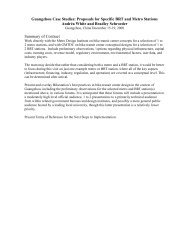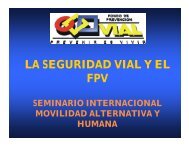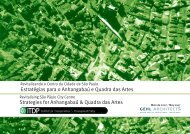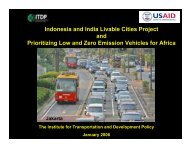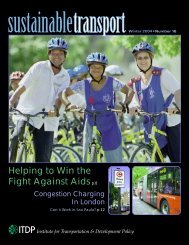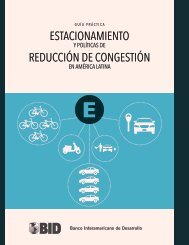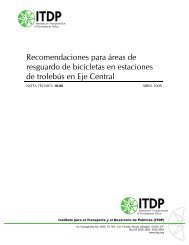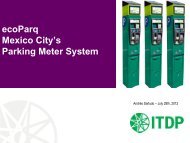BRT Standard - ITDP | Institute for Transportation and Development ...
BRT Standard - ITDP | Institute for Transportation and Development ...
BRT Standard - ITDP | Institute for Transportation and Development ...
Create successful ePaper yourself
Turn your PDF publications into a flip-book with our unique Google optimized e-Paper software.
The <strong>BRT</strong> <strong>St<strong>and</strong>ard</strong> Version 1.0<br />
4<br />
Foreword<br />
The first bus rapid transit system opened in Curitiba, Brazil, in<br />
1974, <strong>and</strong> remains one of the best in the world today. After its<br />
opening, there were many imitators across Brazil <strong>and</strong> in other<br />
countries, including the United States. Some of these imitators<br />
brought real improvements, but most had only a h<strong>and</strong>ful of the<br />
elements that made Curitiba’s <strong>BRT</strong> such a phenomenal success.<br />
A few of these busways, by concentrating large numbers of<br />
polluting old buses onto a single corridor, slowed buses down<br />
<strong>and</strong> blighted adjacent real estate. The Brazilian general public,<br />
unfamiliar with the technical differences between the Curitiba<br />
<strong>BRT</strong> system <strong>and</strong> other busways, became disillusioned with <strong>BRT</strong><br />
as a solution to its mass-transit problems, <strong>and</strong> from the mid-<br />
1980s until 2012 no new full-featured <strong>BRT</strong> systems were built<br />
in Brazil.<br />
Starting in 1998, there was a second wave of <strong>BRT</strong> systems.<br />
Most significantly, in 2000, Bogotá opened the TransMilenio <strong>BRT</strong><br />
system. TransMilenio significantly surpassed Curitiba in terms<br />
of speed, capacity, quality of service, <strong>and</strong> the richness of services<br />
offered. Its success spurred a number of cities worldwide to build<br />
<strong>BRT</strong> systems, some of which turned out extremely well, bringing<br />
new innovations <strong>and</strong> refinements. The <strong>Institute</strong> <strong>for</strong> <strong>Transportation</strong><br />
<strong>and</strong> <strong>Development</strong> Policy (<strong>ITDP</strong>) <strong>and</strong> other members of the <strong>BRT</strong><br />
<strong>St<strong>and</strong>ard</strong> committee have been lucky enough to be involved in<br />
many of these projects. As a result of this rapidly growing body<br />
of experience with <strong>BRT</strong> systems, the international <strong>BRT</strong> technical<br />
community has a much better underst<strong>and</strong>ing today of the<br />
essential elements of the best <strong>BRT</strong> systems than it did a<br />
decade ago.<br />
At the same time, because there was no agreement on a<br />
quality st<strong>and</strong>ard <strong>for</strong> <strong>BRT</strong> systems, history began to repeat itself.<br />
For every new <strong>BRT</strong> system that was world class, dozens opened<br />
that lacked many of the essential features of <strong>BRT</strong>. The residents<br />
<strong>and</strong> decision makers in cities where these systems were built<br />
were largely unaware of the differences between their system<br />
<strong>and</strong> the best <strong>BRT</strong> systems. As happened in Brazil in the 1980s,<br />
in a growing number of such cities, the public <strong>and</strong> political<br />
leaders came to associate <strong>BRT</strong> with a quality of service<br />
significantly inferior to what was expected from rail-based<br />
alternatives. This phenomenon occurred in countries from<br />
the United States to China, India, <strong>and</strong> Indonesia, where some<br />
new systems were built that actually made conditions worse<br />
<strong>for</strong> transit passengers.<br />
Starting in 2010, <strong>ITDP</strong>, with support from the Rockefeller<br />
Foundation, decided that the time was right to develop a <strong>BRT</strong><br />
<strong>St<strong>and</strong>ard</strong>. It was initially developed as a metric <strong>for</strong> determining<br />
the degree to which existing <strong>BRT</strong> systems in the U.S. were<br />
consistent with international best practice. As we faced a similar<br />
need in other countries, we began to recognize the applicability<br />
of the st<strong>and</strong>ard <strong>for</strong> international use.<br />
In 2011 <strong>ITDP</strong> convened a meeting in Bogotá bringing together<br />
engineers who had worked on the highest-quality <strong>BRT</strong> systems.<br />
Together, we tried to further distill the system features most<br />
critical to good <strong>BRT</strong> per<strong>for</strong>mance, <strong>and</strong> to weigh them in terms of<br />
their relative importance. While there was much dispute on the<br />
margins, the technical community already had a fairly common<br />
underst<strong>and</strong>ing of the essential elements of best practice in <strong>BRT</strong><br />
systems. Throughout 2011 the scoring system was further vetted<br />
with experts from the U.S. <strong>and</strong> abroad, then tested on dozens of<br />
systems to see whether the scores seemed consistent with the<br />
better-per<strong>for</strong>ming systems.<br />
This document, the <strong>BRT</strong> <strong>St<strong>and</strong>ard</strong> version 1.0, was developed<br />
as a result of that year-long ef<strong>for</strong>t.<br />
We hope that the <strong>BRT</strong> <strong>St<strong>and</strong>ard</strong> will help encourage<br />
municipalities to at least consider the key features of the best<br />
<strong>BRT</strong> systems, <strong>and</strong> that a few cities will be inspired to go beyond<br />
what has been done be<strong>for</strong>e. We hope it will be useful to citizens’<br />
groups, allowing them to dem<strong>and</strong> better quality <strong>and</strong> per<strong>for</strong>mance<br />
from their political leaders. Finally, we look <strong>for</strong>ward to certifying<br />
<strong>and</strong> celebrating those cities that succeed in developing the<br />
highest-quality <strong>BRT</strong> systems.<br />
Sincerely,<br />
Walter Hook<br />
Chief Executive Officer, <strong>ITDP</strong>





